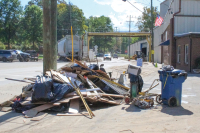Is anyone counting the losses?
By Sami Felmet • Guest Columnist
The birds and the bees. We’re losing them, you know. How will we explain reproduction without them? Maybe it’s easier now with so much sex on TV and in the movies. Is it any wonder the little darlings are having sex younger and have no respect for fidelity? The word is still in Webster’s, but that page is spanking clean at the library.
Back to the subject.
About mid-June a report was released that indicated the populations of 20 common American birds are half what they were 40 years ago. What struck me was that one of the most affected is the whippoorwill. I realized it’s been years since I’ve heard one. Causes? Do we need to ask? Suburban sprawl, climate change and invasive species. It doesn’t name the invasive species and I went looking. I wouldn’t think it qualifies as a species, but West Nile Virus is a critical factor.
Many of those on the list of declining population are dependant on open grassy habitat. I know the bluebird likes the wide open spaces. I have a friend who helps maintain houses all over the Laurel Ridge Golf Course. I’ve ridden with her to check the houses. She’s ruthless if she finds the nest of another bird. Those upscale residences are not just for the birds. Bluebirds only, please. She grieves when it turns cold again after the eggs have been laid because each egg needs a fair chance.
The evening grosbeak has diminished 78 percent in the last 40 years. Now you see them. Now you don’t. One of my favorites that’s been hard hit is the little chickadee.
A lot of the birds on the long list don’t show up around here, but one that does is the field sparrow. I see plenty but they are on the list. The common grackle is on the list too. I know some will be pleased by that news. I’d like to add the blue jay. Is there a more obnoxious creature?
How long since you’ve heard a bob-white? Last year, in Massachusetts, counters only found three of them. So far, he seems to be the biggest loser.
Bees are in much worse shape. Do you know what happens if we don’t have bees?
Crops like wheat and corn are pollinated by the wind, but everything from apples to watermelons depend on the honeybee. Honeybees have pollinated every third bite of food we take.
It’s a new realization and research is only beginning. Beekeepers suspect everything from a new virus or parasite to pesticides and genetically modified crops. In recent weeks the U.S. House of Representatives Committee on Agriculture held hearings on what’s happening to the bees. No word on what they decided. It might not hurt to ask your congressman to take a look at what can be done.
Once again the blame seems to rest on human activity. Habitat loss, pesticide use and imported disease. One thing we can do is plant trees and flowers that bloom throughout the seasons. One more thing might be when you’re thinking of grading off another mountainside, consider the birds and the bees.
(Sami is a WNC native and Haywood County resident who appraises antiques, redesigns properties and writes. She can be reached at This email address is being protected from spambots. You need JavaScript enabled to view it.)





